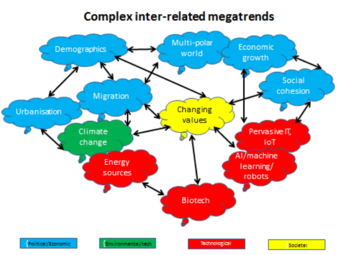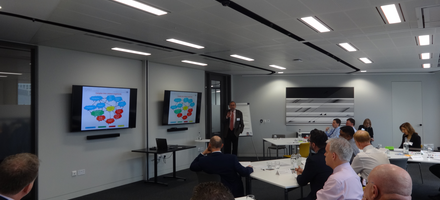
Drivers of change and futures thinking tools
Progress indicator
Huw Williams, Principal at SAMI Consulting, describes the main megatrends that quality professionals should keep in mind, while planning for the future of their organisation.
The world is changing quickly in complex inter-related ways. This article outlines many of the key drivers of change in politics, society, economics, environment and technology, exploring several tools that can be used to aid thinking about the implications of these changes for your organisation and for the quality profession.
Drivers of change
Some change is unpredictable but there are also many major trends which can be identified from research. For these it is generally the scale and speed of change, and second-order effects, that are uncertain.
SAMI Consulting maintains a constant review of emerging events and has compiled a set of 12 key drivers of change – megatrends – which nonetheless are linked. A standard approach to identifying sources of change is called STEEP – societal, technological, environmental, economics and political. In the diagram below we have combined economics and political as they are so closely linked.

The 12 megatrends are:
Demographics
- Growing world population: the world population will grow from 7.5 billion in 2017. to 11.2 billion by the year 2100; but the rate of growth is declining: from 2.06% per annum between 1965-1970, to just 0.13% by 2100; much of the growth comes from Africa due to increased life expectancy rather than increasing birth rates.
- Ageing population in Europe: the median age in Europe is forecast to increase from 37.7 years old in 2003 to 52.3 years old by 2050. Inevitably this brings pressure on welfare and health systems.
Multi-polar world
According to the European Parliamentary Research Service, Global Trends Unit, we are seeing a shift in the global economic centre of gravity from West (to East and South (especially Africa, but also Russia and China). In the medium-term, developing countries will push to raise standards and the developed countries will seek to engage with these markets.
Economic growth and inequality
In the OECD there are increasing returns to capital at the expense of labour and growing inequality within countries. The ‘gig economy’, part-time working and zero-hours contracts as well as an increase in the grey economy puts strains on tax receipts and social community.
Globally, there is decreasing inequality between countries, as poorer countries catch up.
Social cohesion
Social cohesion is deteriorating due to rising inequality, imbalances in economic opportunity, worsening economic conditions and the inability of governments in dealing with increasing immigration/diversity in societies. This trend is manifesting itself in the rise of populist/anti-diversity parties, calls to close borders and increasing alienation among groups.
Climate change
Climate Action Tracker suggested that the Paris Climate Agreement would lead to a global temperature rise of between 2.2C and 3.4C – assuming everyone hit their targets. A 1.5C requires virtually zero emissions; it is possible but needs political force, and perhaps ‘geo-hacking’.
Energy sources
Sources of energy are diversifying with more renewables and less fossil fuels. Diversified energy sources will redistribute the current economic/political power among countries reducing the geopolitical importance of oil-producing areas such as Saudi Arabia, and Texas and Alaska in the US. Intermittency of renewables leads to the need for innovative ways of storing energy (batteries, flow batteries, biofuels, hydrogen), and decentralised generation forces changes to the grid.
Pervasive IT
We will see an increasingly interconnected world as rapid developments of Internet of Things/autonomous vehicles/rise of VR (virtual reality) and AR (augmented reality) occur. Growing ‘Industry 4.0’ manufacturing – 3D printing and decentralised, localised ‘just-in-time’ goods production – emphasising design and IPR (intellectual property) profits rather than production profits. Cybercrime becomes an increasing risk, and privacy issues come to the fore.
Artifical Intelligence (AI) and robots
AI is starting to affect not just blue-collar and routine white-collar jobs, but professionals too. . In the legal profession for example there are already AI-driven chatbots, and research (Susskind and Susskind) suggest we will see a “hollowing out” of the profession as lower and middle-rank roles are automated. AI will transform knowledge work and replace much human decision-making, making other skills like empathy more important. New jobs may be created too, but disruption to industry is likely.
Biotech
The emerging bio-age (personal medicine, manufacturing in fermentation vats, bio-engineered chemical production, bio-data storage etc.) and rapid progress in genome editing (CRISPR) will have an impact on food production, health, medicine, lifestyle and longevity.
Migration
Around one million migrants a year have been arriving in Europe since 2015, mostly from Syria, Afghanistan and Iraq. That compares with a European population of about 750 million; so their overall demographic impact (e.g on ageing) will be limited, though politically it remains an issue. Increased global warming may increase migration and cause ongoing societal tensions.
Urbanisation
Urbanisation will continue as cities continue to offer economies of scale in supplying infrastructure services to people, creating huge social, economic and environmental changes/challenges. The United Nations has projected that nearly all global population growth from 2017 to 2030 will be absorbed by cities, about 1.1 billion new urbanites over the next 13 years.
Changing values across generations
We see a value shift across generations resulting in growing conflict with ‘outmoded perspectives’ of older generations still in power. Millennials are exhibiting a shift from consumerism to collectivism, but it’s not clear whether this is just a phase. There is also an increasing acceptance of sexual diversity – trans, non-binary, gender-fluid. Generation Z (people born between mid-1990s to the early 2000s) smoke less, drink less alcohol and have less underage sex. On the other hand they are more likely to be obese and experience increased mental health issues.
Tools for futures thinking
Some of the more popular tools for helping organisations think about the uncertainties of the future include:
- Scenario planning and wind-tunnelling: envisioning different ways the future may develop and testing strategies against them.
- Horizon Scanning: systematic search for emerging trends.
- Three Horizons: plotting the emergence of change.
- Futures Wheels: exploring second- and third-order effects of change.
- Causal Layered Analysis: examining the underlying assumptions and mindsets beneath an issue.
About the author: Huw Williams is a Principal at SAMI Consulting. He recently held a presentation about new trends and emerging issues that will affect quality professionals in the future, for CQI’s Corporate Connect event ‘Scenario Planning and Future’s Thinking’, in London.
Find out more
For more information on these and other tools and to learn more about ‘A futures thinking consultancy’, visit:
Quality World

Get the latest news, interviews and features on quality in our industry leading magazine.

